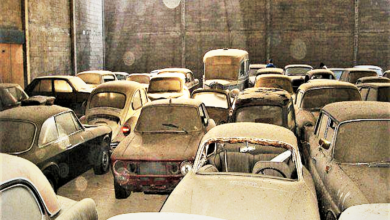Rare Rides: The 1969 Dodge Coronet R/T 426 Hemi Convertible.
In past pages of this column, we have taken a look at many of the world’s scarcest muscle cars.
Two options in particular that could jack the price of a Mopar through the roof had one-word names: “convertible” and “Hemi.” Today, we’re going to examine a car that featured both and was consequently one of the rarest Mopars ever built.
The car I’m referring to? The 1969 Dodge Coronet R/T 426 Hemi Convertible!
The 1969 Dodge Coronet R/T 426 Hemi Convertible had a long lineage that stretched back two decades and comprised five distinct generations of design.
The Coronet, whose name translates to “little crown,” was introduced with the first wave of Dodge vehicles to be produced after the end of the Second World War. Released in 1949, it was a full-sized vehicle with two lesser trim models, the Wayfarer and Meadowbrook, beneath it in the lineup.
The redesigned 1953 Coronet sedan.
After a slew of aesthetic refreshes, Dodge launched a completely redesigned Coronet in 1953 which featured the introduction of the optional “Red Ram” 241ci-Hemi V8. The new powerplant featured a two-barrel carb and a 7.1:1 compression ratio, good for 140 horsepower. Equally noteworthy was the 1954 introduction of Chrysler’s first automatic transmission, the two-speed PowerFlite, as an extra-cost option.
The ’55 Coronet coupe.
Another redesign followed in 1955 and saw the Coronet relocated to the lower end of the Dodge line. Now longer and wider, and offering a trio of engine choices that included the venerable 230 I6, and 270 cubic-inch and 315 cubic-inch Hemi V8s, the Coronet enjoyed a good boost in sales.
A 1957 Dodge Coronet Convertible.
’57 Coronets were offered in club sedan, Lancer hardtop coupe, convertible, hardtop sedan, and two- and four-door station wagon layouts.
Despite robust sales, the Coronet name was retired after the 1959 model year to make way for a new lineup. But this was far from the end for the Little Crown, as the Coronet reappeared in 1965. The fifth-generation car was now a mid-level offering, riding on the B-body platform, and featuring the svelte, Jet-Age lines dominating the auto industry at the time.
A 1965 Coronet 500.
The new Coronet lineup consisted of 17 models, available in four distinct series: the Coronet, Coronet Deluxe, Coronet 440, and Coronet 500. The base Coronet and deluxe series offered two- and four-door sedans, while the Coronet 440s could be had in two-door hardtop, two-door convertible, four-door sedan, and four-door station wagon models. The top-of-the-line Coronet 500 series came only in two-door hardtop or convertible versions.
The all-new 1968 Dodge Coronet R/T.
Stand-out features of the new design included a recessed, blacked-out grille encompassing quad lamps and a full-width chrome bumper up front, a “power bulge” hood, and twin recesses on each quarter panel ahead of the rear wheel arches. Segmented taillamps featuring concave lenses adorned the rear, while finishing touches included a small army of R/T emblems and a contrasting “Bumble Bee” stripe at the aft end.
The ’68 Coronet redesign was a resounding hit with the public, with roughly 189,500 units sold overall. Of those, nearly 10,900 were R/Ts, with 230 of them equipped with the Hemi and 569 of them being convertibles. Exact figures for ’68 Hemi convertible production is murky, but most estimates suggest the number was in the low double digits.
The 1969 Dodge Coronet R/T Hemi Convertible
All of these changes resulted in what many consider to be the finest-looking Coronet of all.
The 1969 Hemi convertible was now even more dear in price, with the Hemi costing an astonishing $718, and the convertible top option adding another $330. As such, it makes sense that very few people would opt for this configuration.
In fact, out of the 107 documented Hemi cars manufactured in 1969, only ten were ragtops, making it a true unicorn of the Golden Era.
One of the great rare rides.
Quite a bit of money for a car that rolled out of the factory with a $4,892.90 window sticker for sure, but totally understandable given that it is now one of the world’s greatest Rare Rides.











